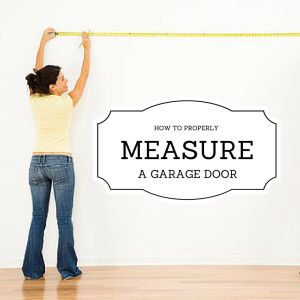 The literal ups and downs of a garage door are such that eventually the need to replace it becomes an issue. However, given the many different models and sizes, the numbers of questions that surface as a result can be confusing. In the case of the size, knowing how to measure a garage door and the radius becomes extremely important for the consumer.
The literal ups and downs of a garage door are such that eventually the need to replace it becomes an issue. However, given the many different models and sizes, the numbers of questions that surface as a result can be confusing. In the case of the size, knowing how to measure a garage door and the radius becomes extremely important for the consumer.
That’s because a door isn’t much good if the necessary homework hasn’t been done. As a rule of thumb, the average one-car garage requires a door size of 8 x 7 feet, and the two-car version demands one that’s 16 x 7 feet. Listed below is a quick primer on how to accurately measure a garage door.
First Step
The width of the door opening, which is the distance between the finished opening right and left sides, should be measured at the widest point. Once that’s been completed, the garage door’s inside needs to be framed with wood that’s 2 x 6 inches, preferably a jamb. For those unfamiliar with a jamb, it’s simply a board that forms the side of a door. In all cases, the header needs to be stable and jambs need to be in good condition.
Second Step
The height of the opening at its highest point should be measured, which is generally defined as the distance between the finished opening and the floor. In some cases, the need to account for an uneven floor may be necessary.
Third Step
The areas besides the opening have to have their width measured. In order to make sure a vertical track can be properly installed, a one-car garage requires the width to be 3 ¾ inches. If this is a two-car garage, the center post needs to be at least 10 inches wide.
Fourth Step
The area between the ceiling and the top of the door opening has to be measured. In the event of an obstruction, the lowest of these should replace the ceiling when measuring. When it comes to door installations, most doors need 12 inches of headroom, but if this a Carriage House model, that number rises to 15 inches. Regardless of the type of door, the additional inches will be needed to accommodate an opener.
Fifth Step
Determining the distance between the back of the garage (or whatever obstruction may be in place) and the opening is needed. If the plans include the installation of an electric door opener, the backroom on the door needs to be calculated as such: door height plus 50 inches. However, if sectional doors (or similar options) are the choice, the math is determined this way: door height plus 18 inches for the manual lift version
Key Factors
It’s important that all aspects of the makeup of the garage be included. This means determining if any lights or stairs are currently in the way. In addition, checking above the door for any ductwork, pipe or any other potential obstruction is important. Finally, an electrical outlet needs to be available if a door opener is part of the equation.
Radius Determination
The amount of headroom in a garage is the determining factor between either a 12-inch or 15-inch radius. A sharper curve exists on the 12-inch radius and it opens lower than the 15-inch version.
One quick rule of thumb in finding out what you have is to measure the height of the track, stopping at the bottom. If that distance is 91 inches or shorter, the radius will be 12-inch.
Call on the Professionals
Texas Overhead Doors has been in the business for over three decades and can offered experienced staff that are equipped to handle the job. Contact us when it’s time for any issues related to your garage door.







Amazing informative article on how to measure a garage door. It’s really helped me a lot. Many many thanks for sharing with us this great article. Looking forward to getting more resource about the garage. Thanks.